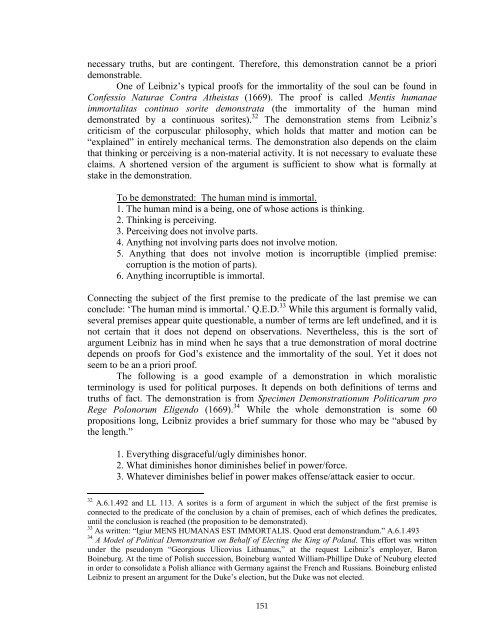Stony Brook University
Stony Brook University
Stony Brook University
Create successful ePaper yourself
Turn your PDF publications into a flip-book with our unique Google optimized e-Paper software.
necessary truths, but are contingent. Therefore, this demonstration cannot be a priori<br />
demonstrable.<br />
One of Leibniz’s typical proofs for the immortality of the soul can be found in<br />
Confessio Naturae Contra Atheistas (1669). The proof is called Mentis humanae<br />
immortalitas continuo sorite demonstrata (the immortality of the human mind<br />
demonstrated by a continuous sorites). 32 The demonstration stems from Leibniz’s<br />
criticism of the corpuscular philosophy, which holds that matter and motion can be<br />
“explained” in entirely mechanical terms. The demonstration also depends on the claim<br />
that thinking or perceiving is a non-material activity. It is not necessary to evaluate these<br />
claims. A shortened version of the argument is sufficient to show what is formally at<br />
stake in the demonstration.<br />
To be demonstrated: The human mind is immortal.<br />
1. The human mind is a being, one of whose actions is thinking.<br />
2. Thinking is perceiving.<br />
3. Perceiving does not involve parts.<br />
4. Anything not involving parts does not involve motion.<br />
5. Anything that does not involve motion is incorruptible (implied premise:<br />
corruption is the motion of parts).<br />
6. Anything incorruptible is immortal.<br />
Connecting the subject of the first premise to the predicate of the last premise we can<br />
conclude: ‘The human mind is immortal.’ Q.E.D. 33 While this argument is formally valid,<br />
several premises appear quite questionable, a number of terms are left undefined, and it is<br />
not certain that it does not depend on observations. Nevertheless, this is the sort of<br />
argument Leibniz has in mind when he says that a true demonstration of moral doctrine<br />
depends on proofs for God’s existence and the immortality of the soul. Yet it does not<br />
seem to be an a priori proof.<br />
The following is a good example of a demonstration in which moralistic<br />
terminology is used for political purposes. It depends on both definitions of terms and<br />
truths of fact. The demonstration is from Specimen Demonstrationum Politicarum pro<br />
Rege Polonorum Eligendo (1669). 34 While the whole demonstration is some 60<br />
propositions long, Leibniz provides a brief summary for those who may be “abused by<br />
the length.”<br />
1. Everything disgraceful/ugly diminishes honor.<br />
2. What diminishes honor diminishes belief in power/force.<br />
3. Whatever diminishes belief in power makes offense/attack easier to occur.<br />
32 A.6.1.492 and LL 113. A sorites is a form of argument in which the subject of the first premise is<br />
connected to the predicate of the conclusion by a chain of premises, each of which defines the predicates,<br />
until the conclusion is reached (the proposition to be demonstrated).<br />
33 As written: “Igiur MENS HUMANAS EST IMMORTALIS. Quod erat demonstrandum.” A.6.1.493<br />
34 A Model of Political Demonstration on Behalf of Electing the King of Poland. This effort was written<br />
under the pseudonym “Georgious Ulicovius Lithuanus,” at the request Leibniz’s employer, Baron<br />
Boineburg. At the time of Polish succession, Boineburg wanted William-Phillipe Duke of Neuburg elected<br />
in order to consolidate a Polish alliance with Germany against the French and Russians. Boineburg enlisted<br />
Leibniz to present an argument for the Duke’s election, but the Duke was not elected.<br />
151
















